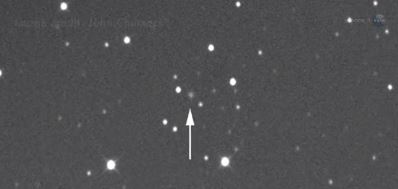

| Visitors Now: | |
| Total Visits: | |
| Total Stories: |

| Story Views | |
| Now: | |
| Last Hour: | |
| Last 24 Hours: | |
| Total: | |
New Photos Of ISON: Comet Of The Century
Out near the orbit of Jupiter, a faint speck of light is moving through the black of space. At first glance it doesn’t look like much, no brighter than a thousand distant stars speckling the velvet sky behind it; indeed, it takes a big telescope make out that it is a comet.
But what a comet it could turn out to be….
Later this year, “Comet ISON” could blossom into a striking naked eye object visible even in broad daylight.
“Comet ISON is a sungrazer,” explains Karl Battams of the Naval Research Lab. “The orbit of the comet will bring it very close to the sun, which we know can be a spectacular thing.”
Russian astronomers Vitali Nevski and Artyom Novichonok found the comet in Sept. 2012. It bears the name of their night-sky survey program, the International Scientific Optical Network.
As 2013 unfolds, the comet is still very far away—near the orbit of Jupiter. That’s why it looks like a speck. “But for an object at such extreme distance, it is actually very bright,” says Battams. The comet’s glow suggests that is spewing gas and dust from a fairly large nucleus—“in the 1 to 10 km range,” estimates Matthew Knight of the Lowell Observatory.
On Nov. 28, 2013, this “dirty snowball” will fly through the sun’s atmosphere little more than a million km from the stellar surface. If the comet survives–a big IF–it could emerge glowing as brightly as the Moon, briefly visible near the sun in broad daylight. The comet’s dusty tail stretching into the night sky could create a worldwide sensation.
Some reporters have started calling ISON the “Comet of the Century,” but Don Yeomans of NASA Near-Earth Object Program thinks that’s premature.
“I’m old enough to remember the last ‘Comet of the Century’,” he says. In 1973, a distant comet named Kohoutek looked like it would put on a great show, much like ISON. The actual apparition was such a let-down that Johnny Carson made jokes about it on the Tonight Show. “It fizzled,” says Yeomans. “Comets are notoriously unpredictable.”
“Comet ISON has the potential to live up to the hype, but it also has the potential to do nothing,” agrees Battams.
One hazard is the sun. Tidal forces and solar radiation have been known to destroy comets. A recent example is Comet Elenin, which broke apart and dissipated in 2011 as it approached the sun. Elenin, however, was a much smaller comet.

Click to view an interactive 3D orbit diagram of Comet ISON, courtesy of the JPL Near-Earth
A better comparison, perhaps, is Comet Lovejoy, which flew through the sun’s atmosphere in 2011. Lovejoy emerged intact and wowed observers with a garish tail for weeks.
“Comet ISON is probably at least twice as big as Comet Lovejoy and will pass a bit farther from the sun’s surface” notes Knight. “This would seem to favor Comet ISON surviving and ultimately putting on a good show.
One of the most exciting possibilities would be a partial break-up. “If Comet ISON splits, it might appear as a ‘string of pearls’ when viewed through a telescope,” speculates Battams. “It might even resemble the famous Comet Shoemaker-Levy 9 that hit Jupiter in 1994.”
A break-up would pose no threat to Earth, assures Yeomans. “Comet ISON is not on a collision course. If it breaks up, the fragments would continue along the same safe trajectory as the original comet.”
Whatever happens, northern sky watchers will get a good view. For months after it swings by the sun, Comet ISON will be well placed for observers in the northern hemisphere. It will pass almost directly over the North Pole, making it a circumpolar object visible all night long.
Will Comet ISON fizzle … or sizzle? Stay tuned to Science@NASA for updates.
Author: Dr. Tony Phillips |Production editor: Dr. Tony Phillips | Credit: Science@NASA





I don’t think NASA can be believed about anything pertaining to space. We all know they kept information from the public and doctor digital pictures hiding information. Also, the notion that comets are just “dirty iceballs,” I think is incorrect. Also with data suggesting that our universe is an electrical universe, a comet this size could bring with it a danger to our planet.
Thunderbolts!!! Also this is a very old, it was written in January of last year!
It is incorrect , they are actually ships disguised in rocks and they will invade the Earth, find all religious people and suck the blood out of them
, they are actually ships disguised in rocks and they will invade the Earth, find all religious people and suck the blood out of them